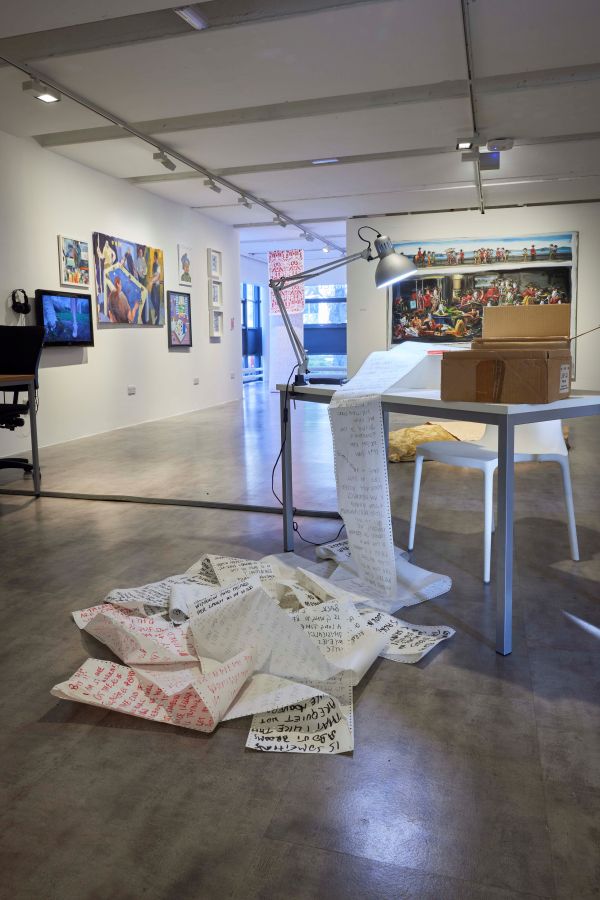By Lucy Taylor.
Stepping into the bustling opening of The Winchester Gallery’s new Work & Play exhibition, I was struck firstly by a real live head lying on a plate in the middle of a cardboard table installation (don’t fear, it was still attached to a living breathing body), and, secondly, by a woman sitting at a desk with reams of dot matrix paper cascading onto the floor writing very intensely, capturing everything that was happening as it happened. The first (pictured top) was part of a trio of pieces from Alice Louisa’s Bread and Butter exploring the value of work. It’s a playful treatment of how we have to serve ourselves up to the labour market when looking for work, where you’re invited to climb into the cardboard box and serve your own head up on a plate. The second was Claudia’s F’s Dot Matrix performance piece, which looks at our obsession with documentation through social media, highlighting its absurdity by looking at it through an analogue lens.
The exhibition was curated by lecturer and artist Julia Vogl along with students from the MA in Contemporary Curating programme at Winchester School of Art. In her words, “The exhibition bridges the experienced and novice artist and a wealth of technical practices as well as diverse senses of humour. What results is a push and pull, similar to the daily challenges of individuals and society to create an equilibrium of work and play- which is essential to wanting to live life.”
Work and Play are so often pitted against one another. Henry Ford once said, “When we are at work, we ought to be at work. When we are at play, we ought to be at play. There is no use in trying to mix the two”. This speaks to a deeply engrained story that we tell about work – that for it to be worth anything, or even for us as humans to be worth anything, we must work hard. The French word for work, travail “connotes not just effort but also suffering”.(1)
And indeed work has historically come with much hardship. In their essay A Queer Feminist Perspective on Work and Play which accompanies the show, Professor Louise Siddons quotes lesbian artist Kady Van Deurs who wrote in 1978, “most people – especially women and blacks and other poor people – are sentenced to do somebody else’s shit work – freeing those other people (mostly men) to be creative”.

Yet what is so present in this show was not suffering but a vibrancy, vitality and a whiff of rebellion. Play as an act of creative resistance – a refusal to let the rigid structures of work, capitalism and patriarchy dim our light. Anzhi Xie’s work, Memo, tells the unlikely story of their experience with mould in their bathroom, reflecting on the tension between wildness and civilization. It reminded me of how Miguel Sicart talks about play – “an activity in tension between creation and destruction.” To him “play is between the rational pleasures or order and creation and the sweeping Euphoria of destruction and rebirth, between the Apollonian and the Dionysian.” Here, play is an edgy, wild force. It has the potential for creativity as well as destruction which seems to be exactly what Anzhi Xie is talking about.
So much of work happens in straight lines – it’s linear, logical and left brained. Play by contrast is curvilinear, disobedient, creative and emergent. As Michael Rosen writes in The Book of Play, when we are playful it “loosens the often rigid boundaries of our very structured world, allowing us to try, allowing us to fail, allowing us to see that success might come in an unexpected shape, colour or configuration.” Play allows the light to get into the dusty corners of our working lives. And this is what this exhibition does.
As someone who spends their life reading, writing, talking and evangelizing about how we make work play it was a delight to see this subject explored from so many different angels. From Turner Prize winner, Gillian Wearing’s Dancing in Peckham as an example of unfettered, defiant, playful expression, to Barbara Graham’s Sketchbook as a place of experimentation and play free from the pressure of a finished work, to Gillian Ayres’s improvised Untitled painting and Jake Blackavar’s Pull Your Socks up, this exhibition will shake your understanding of what it means to work, what it means to play and where the two collide.
So don one of The Aprons (or are they playsuits?) painted by members of Trinity Art Group and get stuck into this playful, thought provoking, inspiring show which runs until 24.5.25 at The Winchester Gallery.
Lucy Taylor is the Founder of Make Work Play Project when she helps groups do hard things in a fun way. She hosts the Why Play Works podcast which speaks to people radically reshaping work as play. She is also a writer and is currently writing a book – Make Work Pay Play.
For more information, visit Lucy’s website: makeworkplay.co.uk, and Julia’s website juliavogl.com.
Gallery is closed over Easter due to University wide closures: 14th – 19th April. The exhibition runs until 24th May.
Closed Mondays. Opening times: Tuesday – Friday 12 – 6pm /Saturdays 12 – 4pm
1 Work: A History of How We Spend Our Time, James Suzman
- In Common is not for profit. We rely on donations from readers to keep the site running. Could you help to support us for as little as 25p a week? Please help us to carry on offering independent grass roots media. Visit: https://www.patreon.com/incommonsoton

